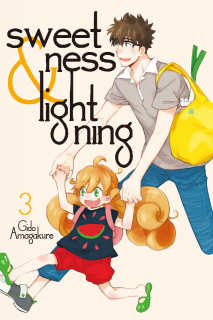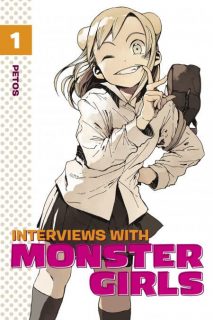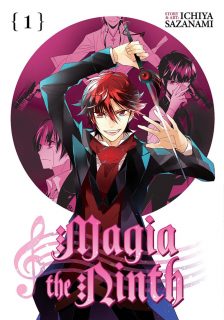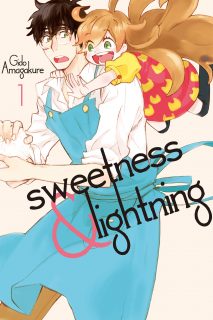My News and Reviews
Last week at Experiments in Manga I posted August’s Bookshelf Overload which lists the manga, comics, and other media that found their way into my home last month. Otherwise, it was fairly quiet here at the blog, but I did come across some great interviews elsewhere online: Paul Semel interviewed author Kazuki Sakuraba whose novel A Small Charred Face will be released in translation this week. (I actually recently reviewed the book; it’s well-worth picking up.) Susannah Greenblatt interviewed Motoyuki Shibata, one of the cofounders of the Monkey Business literary magazine, discussing translation and Japanese literature among other things. (I’ve previously reviewed some of the early issues of Monkey Business.) And for something a little more manga-centric, Brigid Alverson interviewed manga editor Yumi Sukimune who works with Akiko Higashimura on Princess Jellyfish (which I greatly enjoy) in addition to other series.
And then there’s the licensing news from last week. Udon Entertainment, for example has plans to release Yuztan’s Dragon’s Crown manga adaptation. Most of last week’s manga and light novel licensing announcements came from another Seven Seas’ sprees, though: Accomplishments of the Duke’s Daughter manga by Reia and Suki Umemiya; two companion volumes to Kore Yamazaki’s The Ancient Magus’ Bride (which I’ll definitely be picking up); Arifureta: From Commonplace to World’s Strongest manga by Ryou Hakumai and RoGa; the original Cutie Honey manga by Go Nagai; The Dungeon of Black Company manga by Youhei Yasumura; Didn’t I Say to Make My Abilities Average in the Next Life?! light novels and manga by FUNA, Itsuki Akata, and Neko Mint; Go For It, Nakamura! manga by Syundei (probably the one I’m personally most excited about); Himouto! Umaru-chan manga by Sankaku Head; How Not to Summon a Demon Lord manga by Yukiya Murasaki and Naoto Fukuda; How to Treat Magical Beasts manga by Kajiya; Hungry For You: Endo Yasuko Stalks the Night manga by Flowerchild; If It’s for My Daughter, I’d Even Defeat a Demon Lord manga by CHIROLU and Hota; Little Devils manga by Uuumi; Mushroom Girls in Love, a one-volume manga by Kei Murayama; Precarious Woman Executive Miss Black General by Jin; Satan’s Secretary manga by Kamotsu Kamonabe; The Voynich Hotel manga by Seiman Doumanv. It’s an interesting mix!
Quick Takes
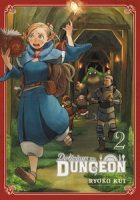 Delicious in Dungeon, Volume 2 by Ryoko Kui. I absolutely loved the first volume of Delicious in Dungeon and after reading the second volume my opinion of the series hasn’t changed–I still find it tremendously entertaining. The conceit of Delicious in Dungeon is fairly simple and straightforward. Basically, Kui has taken a dungeon-crawling adventure and turned it into a food manga. It’s a brilliant combination of subgenres with endless possibilities when it comes to the sheer variety monsters that could end up as a meal for the manga’s protagonists. While this alone could carry the series a fair distance (especially considering the immense creativity Kui exhibits in how fantasy creatures might be used to either directly or indirectly support an adventurer’s diet), Delicious in Dungeon also benefits from having a main cast that largely consists of a bunch of endearing goofballs. Kui has also started to expand on the actual worldbuilding of the series, too. While the manga still relies fairly heavily on the well-established tropes of fantasy role-playing games, small details are being introduced that make the setting of Delicious in Dungeon a little less generic. Of course, part of the series’ humor and charm is firmly based on Kui taking familiar fantasy elements and twisting them just a bit. It’s all great fun.
Delicious in Dungeon, Volume 2 by Ryoko Kui. I absolutely loved the first volume of Delicious in Dungeon and after reading the second volume my opinion of the series hasn’t changed–I still find it tremendously entertaining. The conceit of Delicious in Dungeon is fairly simple and straightforward. Basically, Kui has taken a dungeon-crawling adventure and turned it into a food manga. It’s a brilliant combination of subgenres with endless possibilities when it comes to the sheer variety monsters that could end up as a meal for the manga’s protagonists. While this alone could carry the series a fair distance (especially considering the immense creativity Kui exhibits in how fantasy creatures might be used to either directly or indirectly support an adventurer’s diet), Delicious in Dungeon also benefits from having a main cast that largely consists of a bunch of endearing goofballs. Kui has also started to expand on the actual worldbuilding of the series, too. While the manga still relies fairly heavily on the well-established tropes of fantasy role-playing games, small details are being introduced that make the setting of Delicious in Dungeon a little less generic. Of course, part of the series’ humor and charm is firmly based on Kui taking familiar fantasy elements and twisting them just a bit. It’s all great fun.
 Sweetness & Lightning, Volumes 6-7 by Gido Amagakure. Although I love food manga, I never generally read a particular title thinking that I’ll actually make any of the recipes that might be contained within it. If I ever did, though, Sweetness & Lightning is probably the series that I would turn to. Since the main characters are in the process of learning to cook (and one of them is a preschooler about to start kindergarten), the dishes that they tackle typically tend to be within the reach of a beginner and aren’t usually overly-complicated. The fact that Sweetness & Lightning is a food manga is what initially brought the series to my attention, but at this point it’s really the characters which keep me coming back for more. I’m particularly impressed by the portrayal of the father-daughter relationship between Inuzuka and Tsumugi. Amagakure is also incredibly successful in depicting little kids in a convincing way. Sweetness & Lightning is in turns adorable and bittersweet, and these two volumes have some especially poignant and heartbreaking moments. Since Tsumugi is so young she still doesn’t entirely understand the death of her mother and Inuzuka still grieves the loss of his wife. But the sixth and seventh volumes also introduce more members of their extended family which was lovely.
Sweetness & Lightning, Volumes 6-7 by Gido Amagakure. Although I love food manga, I never generally read a particular title thinking that I’ll actually make any of the recipes that might be contained within it. If I ever did, though, Sweetness & Lightning is probably the series that I would turn to. Since the main characters are in the process of learning to cook (and one of them is a preschooler about to start kindergarten), the dishes that they tackle typically tend to be within the reach of a beginner and aren’t usually overly-complicated. The fact that Sweetness & Lightning is a food manga is what initially brought the series to my attention, but at this point it’s really the characters which keep me coming back for more. I’m particularly impressed by the portrayal of the father-daughter relationship between Inuzuka and Tsumugi. Amagakure is also incredibly successful in depicting little kids in a convincing way. Sweetness & Lightning is in turns adorable and bittersweet, and these two volumes have some especially poignant and heartbreaking moments. Since Tsumugi is so young she still doesn’t entirely understand the death of her mother and Inuzuka still grieves the loss of his wife. But the sixth and seventh volumes also introduce more members of their extended family which was lovely.
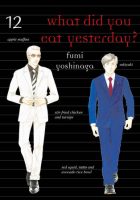 What Did You Eat Yesterday?, Volume 12 by Fumi Yoshinaga. The English-language edition of What Did You Eat Yesterday? has essentially caught up with the original Japanese release so the individual aren’t published as frequently as they once were, but I’m always very happy to get my hands on the latest installment in the series. The food in What Did You Eat Yesterday? is beautifully illustrated from start to finish. The individual ingredients, the techniques used, and the resulting dishes are wonderfully and realistically rendered. Visually, the people in What Did You Eat Yesterday? aren’t nearly as detailed as the food they are eating, but the believably complex and nuanced characterizations in the series is exceptional. The characters certainly have their personal flaws and Yoshinaga isn’t afraid to reveal them; rather than portraying some sort of romanticized ideal, Yoshinaga captures the messiness of real-life relationships in the series. It’s an approach that I particularly appreciate. What Did You Eat Yesterday? follows the day-to-day lives of two adult men who are in a committed, long-term relationship with each other which of course is something that I also greatly value. At times the food aspects of What Did You Eat Yesterday? seem tangential to everything else going on, but it’s still a great series.
What Did You Eat Yesterday?, Volume 12 by Fumi Yoshinaga. The English-language edition of What Did You Eat Yesterday? has essentially caught up with the original Japanese release so the individual aren’t published as frequently as they once were, but I’m always very happy to get my hands on the latest installment in the series. The food in What Did You Eat Yesterday? is beautifully illustrated from start to finish. The individual ingredients, the techniques used, and the resulting dishes are wonderfully and realistically rendered. Visually, the people in What Did You Eat Yesterday? aren’t nearly as detailed as the food they are eating, but the believably complex and nuanced characterizations in the series is exceptional. The characters certainly have their personal flaws and Yoshinaga isn’t afraid to reveal them; rather than portraying some sort of romanticized ideal, Yoshinaga captures the messiness of real-life relationships in the series. It’s an approach that I particularly appreciate. What Did You Eat Yesterday? follows the day-to-day lives of two adult men who are in a committed, long-term relationship with each other which of course is something that I also greatly value. At times the food aspects of What Did You Eat Yesterday? seem tangential to everything else going on, but it’s still a great series.




